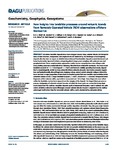New insights into landslide processes around volcanic islands from Remotely Operated Vehicle (ROV) observations offshore Montserrat
| dc.contributor.author | Watt, SFL | en |
| dc.contributor.author | Jutzeler, M | en |
| dc.contributor.author | Talling, PJ | en |
| dc.contributor.author | Carey, SN | en |
| dc.contributor.author | Sparks, RSJ | en |
| dc.contributor.author | Tucker, M | en |
| dc.contributor.author | Stinton, AJ | en |
| dc.contributor.author | Fisher, JK | en |
| dc.contributor.author | Wall-Palmer, D | en |
| dc.contributor.author | Hühnerbach, V | en |
| dc.contributor.author | Moreton, SG | en |
| dc.date.accessioned | 2018-08-14T08:48:02Z | |
| dc.date.available | 2018-08-14T08:48:02Z | |
| dc.date.issued | 2015-07-01 | en |
| dc.identifier.uri | http://hdl.handle.net/10026.1/12144 | |
| dc.description.abstract |
Submarine landslide deposits have been mapped around many volcanic islands, but interpretations of their structure, composition, and emplacement are hindered by the challenges of investigating deposits directly. Here we report on detailed observations of four landslide deposits around Montserrat collected by Remotely Operated Vehicles, integrating direct imagery and sampling with sediment core and geophysical data. These complementary approaches enable a more comprehensive view of large-scale mass-wasting processes around island-arc volcanoes than has been achievable previously. The most recent landslide occurred at 11.5-14 ka (Deposit 1; 1.7 km<sup>3</sup>) and formed a radially spreading hummocky deposit that is morphologically similar to many subaerial debris-avalanche deposits. Hummocks comprise angular lava and hydrothermally altered fragments, implying a deep-seated, central subaerial collapse, inferred to have removed a major proportion of lavas from an eruptive period that now has little representation in the subaerial volcanic record. A larger landslide (Deposit 2; 10 km<sup>3</sup>) occurred at 130 ka and transported intact fragments of the volcanic edifice, up to 900 m across and over 100 m high. These fragments were rafted within the landslide, and are best exposed near the margins of the deposit. The largest block preserves a primary stratigraphy of subaerial volcanic breccias, of which the lower parts are encased in hemipelagic mud eroded from the seafloor. Landslide deposits south of Montserrat (Deposits 3 and 5) indicate the wide variety of debris-avalanche source lithologies around volcanic islands. Deposit 5 originated on the shallow submerged shelf, rather than the terrestrial volcanic edifice, and is dominated by carbonate debris. | en |
| dc.format.extent | 2240 - 2261 | en |
| dc.language.iso | en | en |
| dc.title | New insights into landslide processes around volcanic islands from Remotely Operated Vehicle (ROV) observations offshore Montserrat | en |
| dc.type | Journal Article | |
| plymouth.issue | 7 | en |
| plymouth.volume | 16 | en |
| plymouth.publication-status | Published | en |
| plymouth.journal | Geochemistry, Geophysics, Geosystems | en |
| dc.identifier.doi | 10.1002/2015GC005781 | en |
| plymouth.organisational-group | /Plymouth | |
| plymouth.organisational-group | /Plymouth/Faculty of Science and Engineering | |
| plymouth.organisational-group | /Plymouth/Users by role | |
| dc.identifier.eissn | 1525-2027 | en |
| dc.rights.embargoperiod | Not known | en |
| rioxxterms.versionofrecord | 10.1002/2015GC005781 | en |
| rioxxterms.licenseref.uri | http://www.rioxx.net/licenses/all-rights-reserved | en |
| rioxxterms.type | Journal Article/Review | en |


